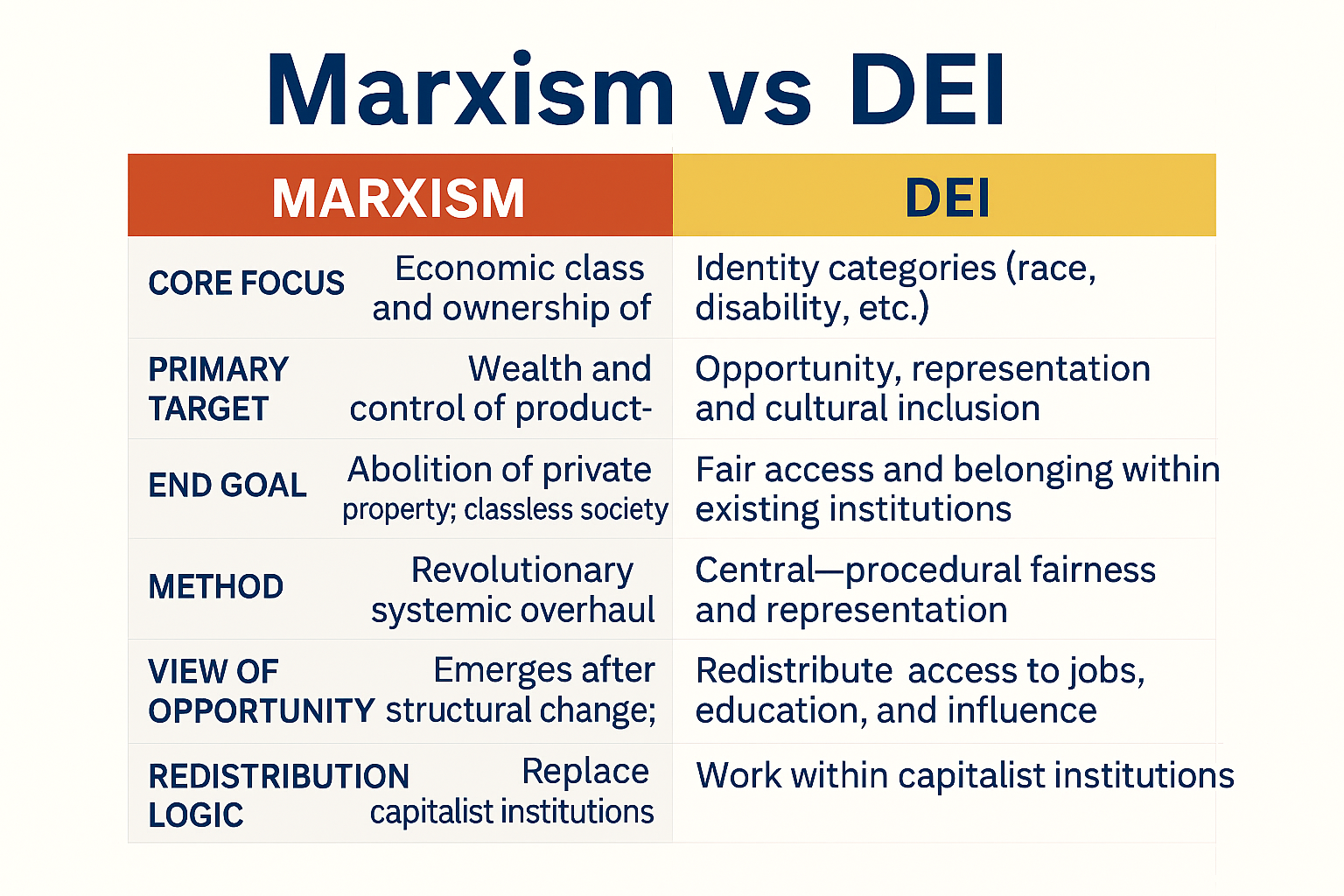1. Overlap Between DEI and Marxism
- Critique of Power Structures: Both DEI (Diversity, Equity, Inclusion) and Marxism challenge existing hierarchies—DEI focuses on race, gender, and identity, while Marxism focuses on class and economic power.
- Redistribution Logic: DEI initiatives often aim to redistribute opportunities and representation, whereas Marxism advocates for the redistribution of wealth and the means of production.
- Language of Oppression: Both use frameworks of systemic oppression—though Marxism centers on economic exploitation, DEI expands to cultural and social dimensions.
2. The conflicting view: DEI as a competitor to merit
A perspective is that DEI initiatives can sometimes prioritize demographic characteristics over merit, leading to conflict. Critics argue that this can result in less-qualified candidates being hired over more-qualified ones to meet diversity metrics or quotas.
- Prioritizing characteristics over performance: Critics express concern that when companies focus heavily on representation targets, a candidate’s race, gender, or other identity markers can be prioritized over their skills, experience, and performance.
- Concerns over “equity”: The “equity” aspect of DEI is a significant point of debate. While proponents define equity as leveling the playing field, critics worry that it can lead to unequal outcomes, where some qualified candidates are passed over to correct past imbalances.
- Perception of lowered standards: The public debate has led to a perception that DEI programs lower hiring standards, even though this is not the intended outcome. This has led to concerns that individuals hired under DEI initiatives will have their qualifications questioned.
- Potential legal challenges: It’s essential to be aware that some legal guidance has targeted DEI programs and hiring practices that involve giving preferential treatment to candidates from underrepresented groups, viewing it as unlawful discrimination. This highlights the importance of carefully and thoughtfully implementing DEI initiatives.
2. Marxism’s Core Aim
Does Marxism misappropriate wealth and opportunity or just wealth?
Marxism primarily targets wealth and the means of production, not “opportunity” in the modern HR sense.
Its central thesis is:
- Abolish private ownership of productive assets (factories, land, capital).
- Redistribute surplus value created by labor, which under capitalism is appropriated by owners.
3. Does it address opportunity?
Indirectly, yes—but through structural change:
- By eliminating class divisions and private property, Marxism assumes equal opportunity emerges naturally because everyone collectively owns and controls production.
- It does not focus on procedural fairness or representation within existing systems (as DEI does). Instead, it seeks to replace the system entirely.
4. So the answer is yes, indirectly
Marxism misappropriates not only wealth but also control over the means of production. “Opportunity” is a downstream effect of abolishing class hierarchy, not a separate policy goal.
5. Divergence
- Foundational Basis:
- Marxism is a materialist philosophy rooted in the concept of economic determinism.
- DEI = identity-based, often postmodern, emphasizing lived experience and representation.
- End Goals:
- Marxism seeks the abolition of class and private property.
- DEI seeks inclusion within existing systems (corporations, academia, governance).
- Methodology:
- Marxism = revolutionary, structural overhaul.
- DEI = reformist, policy-driven, HR frameworks.
6. What’s Really at Stake?
- Cultural vs. Economic Power: DEI shifts focus from economic inequality to cultural recognition, which some argue dilutes class struggle.
- Institutional Capture: While critics argue that DEI can become a corporate compliance tool, its transformative potential should not be overlooked.
- DEI also acts as a counterforce to profitability, as it represents a cost factor but produces no tangible product or service output.
- Polarization: Both frameworks are politicized, but the debates they spark also hold the potential to address more profound questions about meritocracy, fairness, and societal cohesion.
7. Here’s a clear comparison chart between Marxism and DEI, focusing on their treatment of wealth, opportunity, and institutional goals:
|
Dimension |
Marxism |
DEI (Diversity, Equity, Inclusion) |
|
Core Focus |
Economic class and ownership of production |
Identity categories (race, gender, disability, etc.) |
|
Primary Target |
Wealth and control of productive assets |
Opportunity, representation, and cultural inclusion |
|
End Goal |
Abolition of private property; classless society |
Fair access and belonging within existing institutions |
|
Method |
Revolutionary systemic overhaul |
Policy-driven reforms, HR systems, compliance |
|
View of Opportunity |
Emerges after structural change; not explicit |
Central—procedural fairness and representation |
|
Redistribution Logic |
Redistribute surplus value and ownership |
Redistribute access to jobs, education, and influence |
|
Institutional Stance |
Replace capitalist institutions |
Fabrication of working within capitalist institutions |
